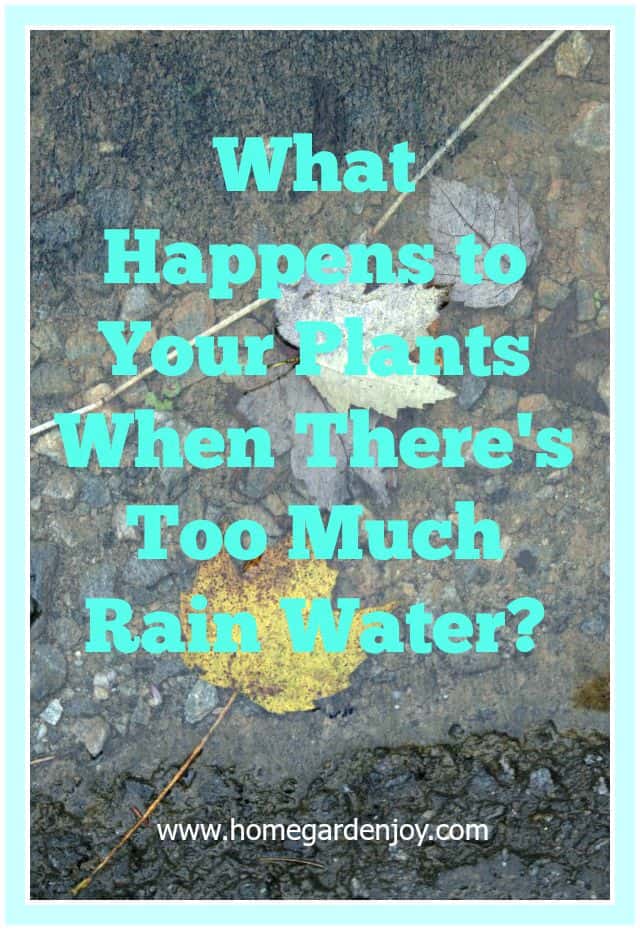Can there every be such a thing as too much rain? I ask this question in all seriousness thanks to several days of pouring rain. I suppose if I lived in the tropics, I’d be used to this. But here in central Virginia it’s unusual. Here’s how to cope with too much rain.
What Happens When There’s Too Much Rain
“You can never have too much of a good thing.” Whoever said that wasn’t a gardener. As I write this, we are now on day 3 or 4 – I’ve lost track – of what feels like a monsoon. The papers on my office desk are damp and limp. My dog has been perpetually stinky despite towel-drying her off every time she goes outside and even blow-drying her long fur last night. Toads and box turtles abound, each drawn from the shelter of the forest floor to venture out to the grass in search of a meal.
Rainwater is better than ground water for plants, as I’ve written before. Research does prove that rain water contains valuable nitrogen, as well as other nutrients essential for plant growth and development. Gardeners do love a good rainstorm, but if we could control the weather the way we can control the valve on our faucets we’d all be a lot happier.
Several things happen to your plants when there’s too much rain:
- Diseases proliferate: Mildew, mold and bacteria love damp conditions. Plants susceptible to powdery mildew, black spot and similar diseases will struggle in the damp weather.
- Pollinators seek shelter: Pollinating insects can’t fly in a downpour, or they can only fly a short distance. Your vegetables and fruit trees actually produce less fruit because of this.
- Tomatoes crack: Tomatoes tend to crack more in wet weather. The skin can’t expand to accommodate all the water inside the fruit, so it cracks to release some. Think of an over-filled water balloon. It pops when you fill it with too much water. That’s what happens to tomatoes.
- Weeds thrive: All those dormant weed seeds waiting for their chance now spring forth in all their glory. But of course, you’re a smart gardener. You know better than to walk around on wet soil right? Walking on wet soil compacts it and harms the soil structure. So the weeds get their day of glory and you’ll have more to battle once the rains stop.
- Grass grows quickly…but you can’t mow: Grass loves cool, rainy weather such as we are experiencing right now in Virginia. Lawn grass grows quickly in such conditions. However, mowing grass while it is wet is not a good idea. Not only is it dangerous for you, but your grass won’t get an even cut, and clumps will form on the mower and on the lawn that could lead to unsightly brown patches as they decompose. While you can mow damp grass, it’s not advisable. Unless you’re running a golf course, just enjoy the lush green lawn while it lasts. Around here, where lawns tend to turn crispy and brown under the unrelenting Virginia sun, a pleasant green sward is a gift.
- Roots can rot: This happens often with container-grown plants and window boxes. Many homeowners forget to drill holes in the bottom of their containers. Others (like me) who slip plain plastic pots into decorative ceramic cache pots forget to lift them out to allow the plastic pots to drain. Today, I took all my outdoor plants out of their cache pots or decorative pots and just let them sit on the bare soil. There was over an inch of water in the bottom of the ceramic pots. This prevents the soil in the plastic container near the plant’s root system from draining. Roots kept soaking wet or perpetually damp can rot, which kills plants.
What happens when there’s too much rain is a long list of problems, but fortunately, God promised Noah He’d never destroy the Earth with another flood, so although it may seem like we should be building a boat thanks to all this rain, it will stop eventually. Until then, sip a cup of cocoa or tea and listen to the beautiful sound of rain. Others across the country suffering from drought aren’t as fortunate.

I would gladly take your rain!!